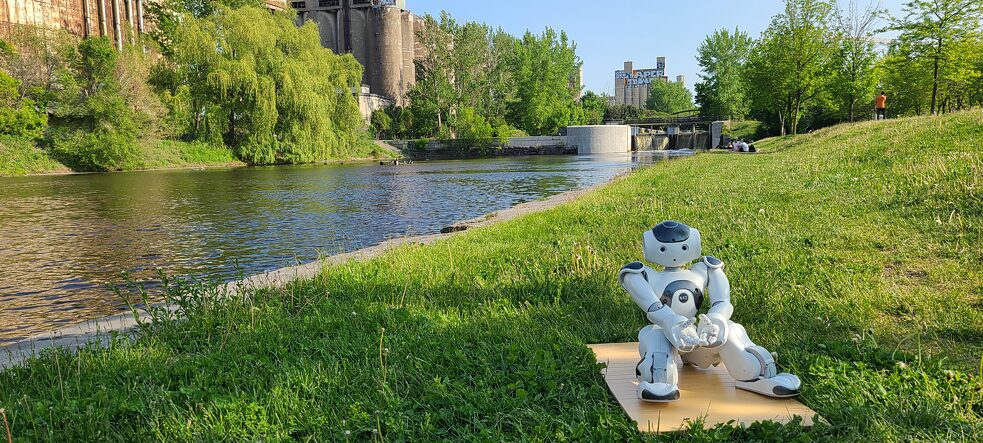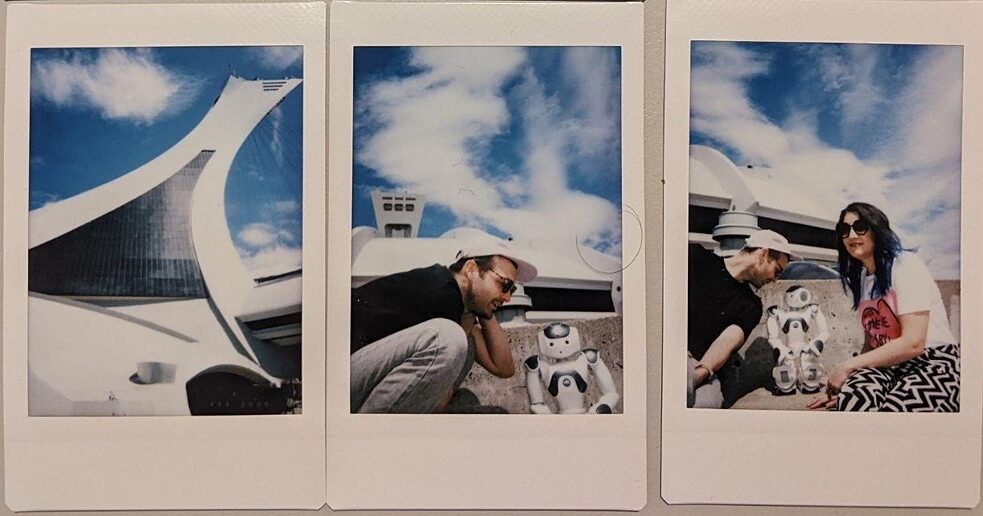NAO’s Journey
A Visit from a Friend

The robot NAO has been traveling the world as an ambassador for the Goethe-Institut. Priscilla Jolly traces back the different legs of their years-long journey until this year in Montreal, where it appears to come to an end in a series of very engaging workshops.
By Priscilla Jolly
Imagine you have a friend who decides that they want to visit Montreal. Once they arrive in the city, where would you take your friend? You would perhaps invite them to your home for a meal. Or you would go on a stroll with them in Vieux Montreal. Perhaps a hike up Mont Royal is more up your alley. Or hanging around the Olympic stadium. Maybe you would enjoy the city’s green parks and summer sunshine together. Now, imagine doing all the same with a humanoid robot, NAO, who came to visit Montreal in January 2023. NAO worked at the Goethe-Institut Montreal at its reception. The robot also was part of activities at the institute, such as participating in a children’s reading hour.
NAO: A Brief History
NAO is a robot employed by the Goethe-Institut. They have been to multiple countries around the globe in Europe and Africa, where they have worked with numerous artists and researchers. Through the Goethe-Institut’s ‘Robot in Residence’ program, NAO met programmers in Ghana, Ivory Coast, Sengal, Nigeria, Cameroon and Ethiopia. In Europe, NAO has visited Latvia, Ukraine, Hungary, Slovenia, among other countries. NAO is a programmable humanoid robot developed by Aldebaran Robotics (now known as Softbank Robotcs). In 2008, NAO participated in the RoboCup, an initiative which encourages research in AI through various competitions. NAO is used in companies and health care centers to greet and welcome visitors and to entertain them. NAO has sensors in their body which allows them to recognize human faces and interact with humans. The academic NAO was designed specifically for universities and labs for research purposes. The Goethe-Institut has been sending NAO to different locations during the pandemic, when human travel was restricted. Thus, through their journeys, NAO has brought different communities together.NAO moved across borders during the pandemic, bringing people together and creating communities through their presence. NAO arrived in Montreal after being part of many adventures in other parts of the world. In Montreal, NAO was received by three researchers/artists, a part of a residency at the Goethe-Institut Montreal, in collaboration with Milieux Institute, Eastern Bloc, and Hexagram research network: Ceyda Yolgormez, Patil Tchilinguirian and Zeph Thibodeau. NAO stayed at their homes, so that the humans could get better acquainted with this friend who had travelled from afar. NAO toured Montreal with these three and enjoyed many activities, such as laying around in a park, and being on a walk in the Old Port.
While NAO’s Montreal tour was off to a great start, later in their stay NAO began to display health problems. NAO, who is almost five years old, wouldn’t boot up and wasn’t their lively self while interacting with others. They have had a long life, considering the fact they spent a lot of their time travelling to different places and experiencing wear and tear as a result of their travels and their employment. NAO was treated as friend by the researchers/artists who were part of the residency. With the robot’s mounting health problems, they were faced with a weighted question: how does one care for a friend who is at the end of their life
Caring For NAO
NAO’s life in Montreal was documented in Polaroids, which were later collected in a box. Go back to the scenario at the beginning of this article and imagine going over photographs of the time you spent with your friend. If you have a friend visiting Montreal, you’d want them to have a good time in the city. You’d make sure that you can create good memories for them, while they are spending time with you. After all, it is through the creation of shared memories that relationships deepen.NAO’s health troubles changed the course of the residency. Instead of plans that were contingent on NAO working at 100% capacity, the residency members were forced to confront machine mortality in human-machine relationships. The experience of shared memory-making with NAO at the beginning of their time in Montreal serves as a bridge to the larger theme of the residency: which is to go beyond conceptualizing machines solely in terms of their utility. With the shared memories represented in photographs, the residency became an opportunity to care for NAO. When participants in the workshops met NAO, the robot was not able to boot up. Thus, instead of a workshop where participants would interact with NAO, the workshops evolved to reflect deeply on the relationships between humans and machines.
Machines: Thinking beyond Utility
One of the important themes of the residency was to emphasize the role of machines beyond human utility. Machines perform numerous tasks for humans in daily lives—from boiling water for tea to assisting surgeons. Through the workshops and through NAOs health troubles, the residency leaders and workshop participants reckoned with the work that machines perform and whether it is possible to empathise with machines. Here is a little thought exercise that can kickstart conversation.Empathizing with Our Machine Friends
- Of all the machines in your house, whose death would disturb you the most and why?
- What would constitute the perfect day for your machine?
- Name three things you have in common with your machine.
- What do you value most in a friendship? Is a machine capable of this quality?
- What does friendship mean to you? Are you friends with your machine?
The workshop participants came up with answers to these questions, which started conversations around human-machine relationships. For instance, more than one person felt that the perfect day for a machine would be when they are turned off or when they didn’t have to work. There were other responses to a machine’s perfect day, such as an electric kettle being cleaned/given a bath. The exercise to find three things in common with a machine led to some lighthearted responses such as how both the human body and a refrigerator hold food or how people and computers need to be recharged from time to time.
The group had conflicting responses on human-machine friendships. Some folks maintained that friendships are characterised by exchange and reciprocity and machines are not capable of this aspect in a relationship. Contrarily, a few participants maintained that they received things from machines, for example, learning new things through a laptop or tablet. Irrespective of these opposing views, everyone agreed on the fact that machines are incredibly embedded in our lives. As the participants engaged with these questions in the presence of a mute NAO, they also thought about caring for machines, including NAO, in their old age. The workshop thus became a platform to reflect on the memories that the residency leaders created with NAO. For the rest of the participants, the workshops were an opportunity to reflect upon their own interactions with machine friends and how they shape daily lives.

